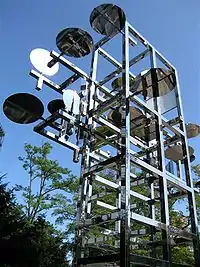Nicolas Schöffer
Nicolas Schöffer (Hungarian: Schöffer Miklós; 6 September 1912 — 8 January 1992) was a Hungarian-born French cybernetic artist.

Schöffer was born in Kalocsa, Hungary and resided in Paris from 1936 until his death in Montmartre in 1992. He built his artworks on cybernetic theories of feedback interactivity primarily based on the ideas of Norbert Wiener. Wiener's work suggested to Schöffer an artistic process in terms of the circular causality of feedback loops.
Schöffer's kinetic art sculpture "CYSP 1" from 1956, that made use of electronic computations developed by the Philips Company, is considered the first cybernetic sculpture in art history. The sculpture is set on a base mounted on four rollers, which contains the mechanism and the electronic brain. The plates are operated by small motors located under their axis. Photo-electric cells and a microphone built into the sculpture catch all the variations in the fields of color, light intensity and sound intensity. All these changes occasion reactions on the part of the responsive sculpture.
References
Sources
- Nicolas Schöffer bio at Monoskop
- Popper, Frank, From Technological to Virtual Art, Leonardo Books, MIT Press, 2007
- Busch, Julia M., A Decade of Sculpture: the New Media in the 1960s (The Art Alliance Press: Philadelphia; Associated University Presses: London, 1974); ISBN 0-87982-007-1
External links
| Wikiquote has quotations related to: Nicolas Schöffer |
- Nicolas Schöffer
- Nicolas Schöffer exhibition
- Images of his studio
- Sound recordings from Schöffer’s spatiodynamic sculptures sourced from the DVD of an exhibition at Espace Gantner, France, 2004, titled Précurseur de l’art cybernétique, as well as various internet videos. The Lumino and Microtemps, 1968 and 1961 respectively, were not intended as sound sculptures, yet the noises they produce are definitely part of their appeal, not unlike Jean Tinguely’s machines.
- Nicolas Schöffer in American public collections, on the French Sculpture Census website